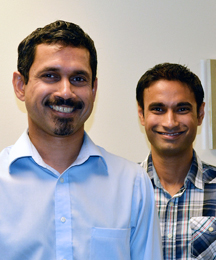Dec 19 2014
Collaborating scientists from The Scripps Research Institute (TSRI) and the University of California (UC) San Diego have developed a powerful new system for studying how proteins and other biological molecules form and lose their natural folded structures.
 “We anticipate that this type of experiment will allow us to detect more complex or hidden features of biomolecule structural landscapes that haven’t been seen before,” said Associate Professor Ashok Deniz (left), here with one of the first authors of the
“We anticipate that this type of experiment will allow us to detect more complex or hidden features of biomolecule structural landscapes that haven’t been seen before,” said Associate Professor Ashok Deniz (left), here with one of the first authors of the
Using the new system, researchers can force a sample of molecules to unfold and refold by boosting and then dropping the temperature, so quickly that even some of the fastest molecular folding events can be tracked.
“One way of studying these structures has been to make them unfold or fold using heat, and to observe the kinetics and other properties of those unfolding and folding events,” said TSRI Associate Professor Ashok A. Deniz. “The new system allows us to do this in a way that overcomes some key limitations of previous methods.”
The invention can be applied to the study not only of normal biomolecules but also many abnormal, misfolding ones that have been implicated in human diseases.
The findings of Deniz’s laboratory and the laboratory of a close collaborator, biophysicist Alex Groisman at UC San Diego, were reported in the most recent issue of Nature Communications.
Too Small, Too Fast
Studying how proteins, DNA and other biological molecules fold is one of the most challenging areas of biology, in particular because these tiny molecules—tinier than the wavelengths of visible light—can fold or unfold in intervals as short as a few millionths of a second (microseconds).
Researchers in this field have come up with some powerful innovations in the past decade or so, including the use of exotic quantum optical phenomena to track fast molecular motions. But techniques for perturbing folded molecules with sudden temperature changes have lagged. “The size of temperature jumps has been limited to about 15 degrees Celsius, and we’ve lacked a way to cool samples quickly back to room temperature,” said Deniz.
In the new study, the Deniz and Groisman laboratories teamed up to develop a device that overcomes both limitations. Their microfluidic device, like others that have been developed in this field, is a small block of silicone fabricated with tiny channels through which a biomolecule-containing solution can flow. In this case, the observation channel is less than a millionth of a meter deep, is lined with sapphire for conducting heat away quickly, and also contains a thin gold plating for effectively absorbing power of an infrared laser beam and converting it into heat.
The combination of the small heating volume and the energy-absorbing gold plating means that the laser can heat a sample of molecules very rapidly, with a temperature jump of more than 50 degrees Celsius in less than a microsecond. The heat-conducting sapphire substrate in turn allows the sample to cool down by several tens of degrees, again within about a microsecond, as soon as the laser is switched off.
Novel Demonstrations
As a simple proof of the new device’s utility, the researchers used it to heat and cool a solution of a short DNA strand that naturally forms a hairpin-shaped loop. Hairpin DNA are dynamic structures that play key roles in cellular replication and other important biological processes.
The experiment, which included fluorescence techniques for detecting folded versus unfolded states of the DNA strand, revealed that the hairpin fold can form in just a few microseconds. “We could not have observed such a rapid folding with previous temperature-jump systems, which typically take thousands of microseconds to cool molecules,” said Priya R. Banerjee, a research associate in Deniz’s laboratory who was a first author of the report with Mark E. Polinkovsky of Groisman’s laboratory, and Yann Gambin, also a member of Deniz’s laboratory during the study. In addition, the scientists used the new setup to study a larger DNA hairpin, together confirming previously predicted behavior about the differential effect of sodium chloride—ordinary salt—on the folding and unfolding kinetics of different sized hairpins.
In a final demonstration of the novel capabilities of their new setup, the scientists were able to probe how the molecular system behaved as a low-pass filter, in some ways similar to ones in electronics or cellular circuits. The team used the ability to switch the heating laser on and off rapidly, combined with the rapid heating and cooling features of the new system, enabling new kinds of studies of molecular folding landscapes. Essentially, researchers can now subject a solution of molecules to a continuous series of heating and cooling cycles, altering the frequency and temperature range of this heating/cooling oscillation at will and observing how the molecules’ unfolding/refolding dynamics change.
“We anticipate that this type of experiment will allow us to detect more complex or hidden features of biomolecule structural landscapes that haven’t been seen before,” said Deniz.
Deniz and his colleagues now plan to use their new system to study the folding dynamics of other molecules, including misfolding-prone proteins that can cause common human illnesses such as Alzheimer’s, Parkinson’s and Huntington’s disease.